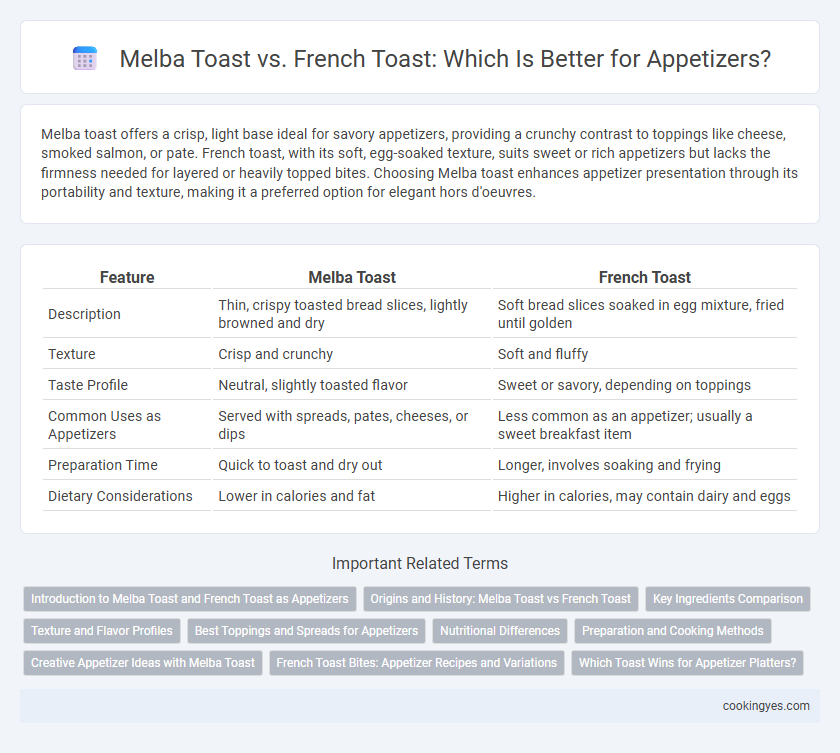Melba toast offers a crisp, light base ideal for savory appetizers, providing a crunchy contrast to toppings like cheese, smoked salmon, or pate. French toast, with its soft, egg-soaked texture, suits sweet or rich appetizers but lacks the firmness needed for layered or heavily topped bites. Choosing Melba toast enhances appetizer presentation through its portability and texture, making it a preferred option for elegant hors d'oeuvres.
Table of Comparison
| Feature | Melba Toast | French Toast |
|---|---|---|
| Description | Thin, crispy toasted bread slices, lightly browned and dry | Soft bread slices soaked in egg mixture, fried until golden |
| Texture | Crisp and crunchy | Soft and fluffy |
| Taste Profile | Neutral, slightly toasted flavor | Sweet or savory, depending on toppings |
| Common Uses as Appetizers | Served with spreads, pates, cheeses, or dips | Less common as an appetizer; usually a sweet breakfast item |
| Preparation Time | Quick to toast and dry out | Longer, involves soaking and frying |
| Dietary Considerations | Lower in calories and fat | Higher in calories, may contain dairy and eggs |
Introduction to Melba Toast and French Toast as Appetizers
Melba toast offers a crisp, thinly sliced, and lightly toasted bread option often served with savory toppings like smoked salmon or cheese, making it ideal for elegant appetizers. French toast, typically sweet with a custard-soaked bread base, can be adapted for appetizers using savory ingredients such as herbs, cheese, or smoked meats. Both Melba toast and French toast provide versatile bases that enhance flavor profiles and presentation in appetizer courses.
Origins and History: Melba Toast vs French Toast
Melba toast, named after Australian soprano Nellie Melba, originated in the late 19th century as a thin, crisp toast served to complement soups and salads, reflecting its roots in British cuisine. French toast dates back to ancient Roman times and gained popularity in medieval Europe as a frugal way to use stale bread soaked in eggs and milk before frying, becoming a breakfast staple worldwide. The distinct origins highlight Melba toast's role as a savory appetizer and French toast's evolution as a sweet or savory breakfast dish.
Key Ingredients Comparison
Melba toast is made from thinly sliced bread that is toasted until crisp and dry, typically seasoned with minimal ingredients like butter or garlic for a light, crunchy texture ideal for savory appetizers. French toast uses thicker bread slices soaked in a mixture of eggs, milk, and sugar before frying, resulting in a soft, sweet, and custard-like base often enhanced with cinnamon or vanilla spices. The key ingredient differences--dry toasted bread versus egg-soaked fried bread--define their distinct textures and flavor profiles in appetizer preparation.
Texture and Flavor Profiles
Melba toast offers a crisp, dry texture with a subtle, toasted flavor that pairs well with creamy or savory toppings in appetizers. French toast features a soft, custardy interior with a slightly sweet and buttery flavor, making it ideal for sweet or savory starters with rich accompaniments. The contrasting textures--Melba's crunch versus French toast's tenderness--create distinct sensory experiences that influence appetizer presentation and pairing choices.
Best Toppings and Spreads for Appetizers
Melba toast offers a crisp, thin base ideal for savory toppings such as smoked salmon, cream cheese, and capers, making it perfect for elegant appetizers. French toast, with its soft and slightly sweet texture, pairs well with fruit compotes, ricotta, and honey for a more indulgent starter option. Choosing between Melba toast and French toast depends on whether a light, crunchy bite or a rich, tender appetizer is desired, with Melba's dryness complementing spreads and French toast enhancing sweeter mixtures.
Nutritional Differences
Melba toast contains fewer calories and less sugar compared to French toast, making it a lighter option for appetizers. French toast typically has higher amounts of carbohydrates and fats due to its egg and milk batter, contributing to increased protein and calorie content. Melba toast is often lower in fat and sodium, appealing to those seeking a crunchy, low-calorie appetizer with minimal added ingredients.
Preparation and Cooking Methods
Melba toast is prepared by slicing bread thinly, then baking it at a low temperature until it becomes crisp and dry, making it ideal for savory appetizers with toppings. French toast involves soaking bread in a mixture of eggs, milk, and spices before frying it until golden brown, resulting in a soft, rich texture suited for sweeter or more indulgent starters. Both methods enhance the bread's flavor and texture but cater to different appetizer profiles through distinct cooking techniques.
Creative Appetizer Ideas with Melba Toast
Melba toast offers a crisp, lightweight base ideal for creative appetizers like smoked salmon with dill cream cheese or goat cheese topped with sun-dried tomatoes. Its thin, crunchy texture contrasts well with rich, savory toppings, making it perfect for elegant hors d'oeuvres at parties. French toast, being soft and sweet, suits breakfast or dessert applications but lacks the versatility and crunch needed for diverse appetizer presentations.
French Toast Bites: Appetizer Recipes and Variations
French Toast Bites offer a versatile appetizer option, combining the rich sweetness of custard-soaked bread with bite-sized convenience, ideal for dipping and sharing. Unlike Melba toast, which is thin, crisp, and typically savory or neutral in flavor, French Toast Bites are soft, fluffy, and often enhanced with cinnamon, vanilla, or fruit toppings. Popular variations include savory versions with cheese and herbs or sweet assortments featuring maple syrup, powdered sugar, and fresh berries, making French Toast Bites adaptable to various appetizer menus.
Which Toast Wins for Appetizer Platters?
Melba toast offers a crisp, light texture ideal for appetizer platters, complementing a variety of toppings like smoked salmon or pate without overpowering them. French toast, with its soft, slightly sweet base, suits dessert-style starters but may overwhelm savory pairings typical in appetizer spreads. For versatile, palate-pleasing appetizers, Melba toast wins by providing a neutral, crunchy platform that enhances both flavors and presentation.
Melba toast vs French toast for appetizers Infographic

 cookingyes.com
cookingyes.com